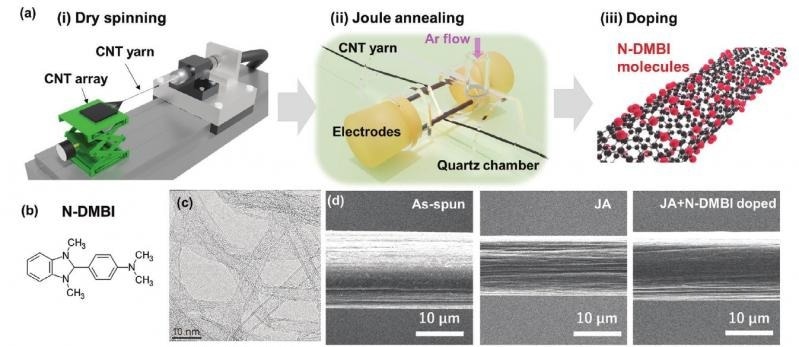Reviewed by Lexie CornerMay 29 2024
Researchers from Okayama University, led by Research Associate Professor Hiroo Suzuki, investigated the use of carbon nanotube (CNT) yarns in thermoelectric conversion. They addressed the shortage of high-performance n-type CNT yarns (which have an excess of electrons) for converting low-grade waste heat, as opposed to the more common p-type CNT yarns (which have an excess of positive charge carriers). This study was published in the journal Small Methods.
 A new n-type doping strategy for carbon nanotube (CNT) yarns. Image Credit: Okayama University
A new n-type doping strategy for carbon nanotube (CNT) yarns. Image Credit: Okayama University
In line with global sustainability efforts, the development of energy harvesting technologies has become a top research priority. Waste heat is a largely unexplored energy source despite the recent attention given to renewable energy sources like wind and solar power. Harvesting industrial waste heat and converting it into electrical energy using thermoelectric materials can improve the efficiency of industrial processes.
This method is less effective for “low-grade” waste heat (reaching temperatures lower than 200 °C). The primary issue is the scarcity of thermoelectric materials at this temperature range.
For applications requiring flexibility, most thermoelectric inorganic materials are either too inflexible, poisonous, or prohibitively expensive to create (such as wearable electronics).
Jun Kametaka, Takeshi Nishikawa, and Yasuhiko Hayashi, all affiliated with Okayama University, co-authored the study.
Constructed from CNTs, CNT yarns are well-suited for practical applications as the yarn-like structure allows for the fabrication of flexible thermoelectric devices such as fabric-based modules, although recent reports have showcased p-type CNT yarns with a remarkable thermoelectric power factor, the absence of similar n-type CNT yarns imposes limitations for device configurations involving π-type modules, which require both p- and n-type CNTs to achieve high efficiency.
Hiroo Suzuki, Research Associate Professor, Okayama University
The study team set out to develop a unique doping (impurity addition) technique to effectively manufacture n-type CNT yarns to address this issue. Due to its great stability in the air—a necessity in the majority of real-world applications—they chose 4-(1, 3-dimethyl-2, 3-dihydro-1H-benzimidazole-2-yl) phenyl) dimethylamine (N-DMBI) as a viable dopant.
Initially, the scientists used a dry spinning method to create CNT yarns. The material is then exposed to an electric current until it achieves a carefully regulated high temperature in a procedure known as the “Joule annealing process,” which was used for these strands.
This manufacturing step makes sense since the brief heat makes the carbon nanotubes more crystalline, lowering their thermal conductivity. This enhances their thermoelectric performance. Additionally, Joule annealing significantly improves the yarn's mechanical qualities.
Subsequently, the group worked to develop the best N-DMBI doping procedure for the CNT yarns.
The optimization of the doping process involved rigorous selection of a suitable solvent. We evaluated ten different options, including nonpolar solvents, polar aprotic solvents, and polar protic solvents, we ultimately identified o-dichlorobenzene as the most suitable solvent for N-DMBI doping at low temperatures, based on an analysis of the resulting Seebeck coefficient of the CNT yarns.
Hiroo Suzuki, Research Associate Professor, Okayama University
Following extensive experimentation, the annealed, n-doped CNT yarns demonstrated a high figure of merit (a numerical expression that indicates a material's performance or efficiency) and an exceptionally high thermoelectric power factor within the temperature range of 30 to 200 °C.
They further tested this n-type material in a prototype π-type thermoelectric generator, which could still generate power at a 55 °C and 20 °C temperature differential.
Achieving power generation at low temperatures with small temperature differences is significant for the development of thermoelectric modules that can tap into various thermal sources, such as waste heat from industrial facilities, thermal dissipation from vehicles, and even body heat.
Hiroo Suzuki, Research Associate Professor, Okayama University
Dr. Suzuki said, “Our research can thus help address energy problems faced by society, contributing to energy saving through the efficient use of otherwise wasted energy. Furthermore, thermoelectric generators can be used as a local energy source to drive IoT devices, such as flexible health sensors.”
The knowledge gained from this research will help create better organic thermoelectric materials, opening the door to more effective waste heat energy collecting. Ultimately, further work in this area can help us progress toward sustainability.
Journal Reference:
Suzuki, H., et al. (2024) N‐DMBI Doping of Carbon Nanotube Yarns for Achieving High n‐Type Thermoelectric Power Factor and Figure of Merit. Small Methods. doi.org/10.1002/smtd.20230138.